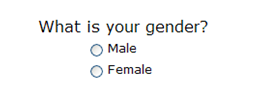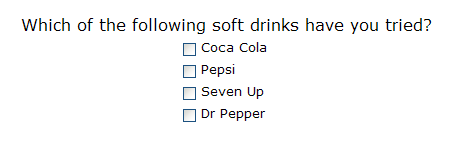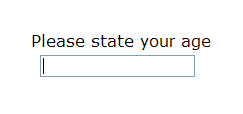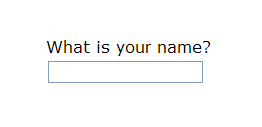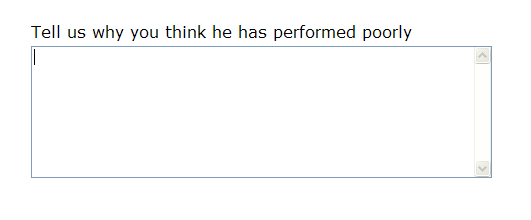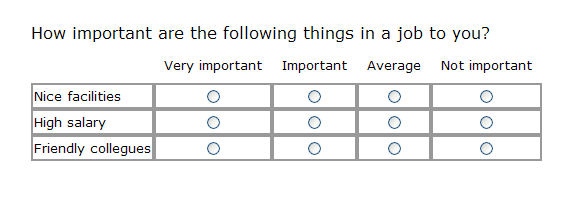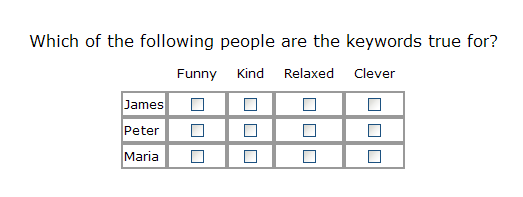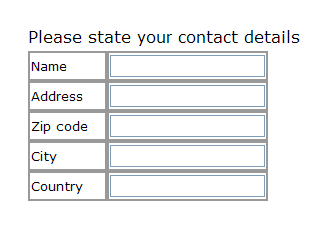Question types
More actions
Question types
Questions can in reality be presented in almost any format. Imagine a question which is a large map of the world where you are asked to click on one country. But the way that the answer is saved is really what defines it, and not the way it is presented. The 'Choose country' question may as well have been a long list of countries with radio buttons in front and the data that would be saved from answering it, would have been the same.
In the following we will show examples of all those question types that exist in Catglobe.
Single question
A single question is a closed question to which you can choose 1 answer option at the most. A typical single question is shown below:
Single questions can be made half open by using the property called 'Open answers'.
Multi question
A multi question is a closed question to which you can choose multiple answers options. A typical multi question is shown below:
Multi questions can be made half open by using the property called 'Open answers'.
Number question
A number question is an question to which you can only give a number as an answer. We can limit the number of answers that can be given by specifying if decimals are allowed and if there is a minimum and maximum allowed value. A typical number question is shown below.
Text question
A text question is an open type question where we expect a short text answer. Text questions cannot be 'half closed'; if users want a half closed question they must use the 'open' question type. A typical text question is shown below.
Open question
An open is obviously open, and differs from a text question in that the system expects a longer answer to the question. There is a lot more need for explanations when you choose an open question as in comparison with a text question where you typically just want tp pick up an answer shorter than an entire sentence. A typical open question is shown below.
Scale question
A scale questions is a numeric question where a user can put a mark on a opinion 'line' starting from a minimum value to a maximum value. The minimum value will typically be identified by a word like 'The least' and the maximum by e.g. 'The most'. Users will then choose a place in between these values that identifies what his opinion is inclined towards. If he chooses the spot right in the middle he will indicate that he neither thinks 'the least' nor 'the most' of the given question; but just somewhere in between! A typical scale question is shown below.
Single grid question
As such it is not really a 'new' question type, but rather a representation of an array of single questions that all have the same set of answer options. When we make a single grid we meet a new term called a 'sub question'. A sub question of a single grid question is in reality a 'single question'. All sub questions of a single grid share a main question, often with the effect that the sub question texts are a lot shorter. A typical single grid question is shown below.
Single grid questions cannot be half open!
Multi grid question
As such it is not really a 'new' question type, but rather a representation of an array of multi questions that all have the same set of answer options. When we make a multi grid we meet a new term called a 'sub question'. A sub question of a multi grid question is in reality a 'multi question'. All sub questions of a multi grid share a main question, often with the effect that the sub question texts are a lot shorter. A typical multi grid question is shown below.
Multi grid questions cannot be half open!
Text grid question
As such it is not really a 'new' question type, but rather a representation of an array of text questions that all are shown in the same table on the same page. When we make a text grid we meet a new term called a 'sub question'. A sub question of a text grid question is in reality a 'text question'. All sub questions of a text grid share a main question, often with the effect that the sub question texts are a lot shorter. A typical text grid question is shown below.
Text grid questions cannot be half open!
Scale grid question
As such it is not really a 'new' question type, but rather a representation of an array of scale questions that all are shown in the same table on the same page. When we make a scale grid we meet a new term called a 'sub question'. A sub question of a scale grid question is in reality a 'text question'. As a difference from single grid and multi grid questions, it is actually possible for scale grids to have different values for minimum and maximum, both in terms of representing numbers as well as labels on each side of the scales.
All sub questions of a scale grid share a main question, often with the effect that the sub question texts are a lot shorter. A typical scale grid question is shown below.
Page 'question'
A page question is not really a question, rather a representation of a step in a questionnaire where no question is asked. Catglobe works by asking people to choose a question type for each step in the questionnaire, and in case the user wants to just show data in one step of the questionnaire the user should choose to insert a page. A typical page is shown below.
Multimedia 'question'
In the same way as a page 'question' and 'multimedia' question is rather a representation of a step in a questionnaire where a multimedia file is shown. Typically user will be shown multimedia questions prior to be asked a question like 'How did you like the commercial you have just been watching?'.

